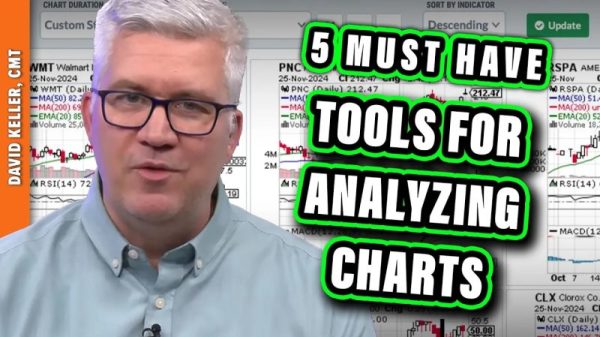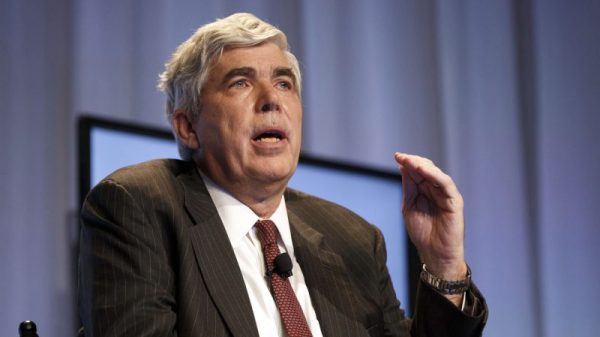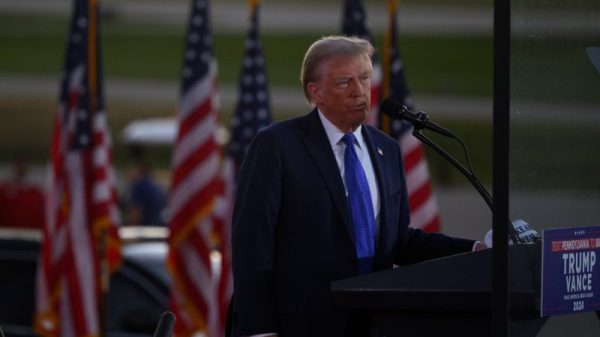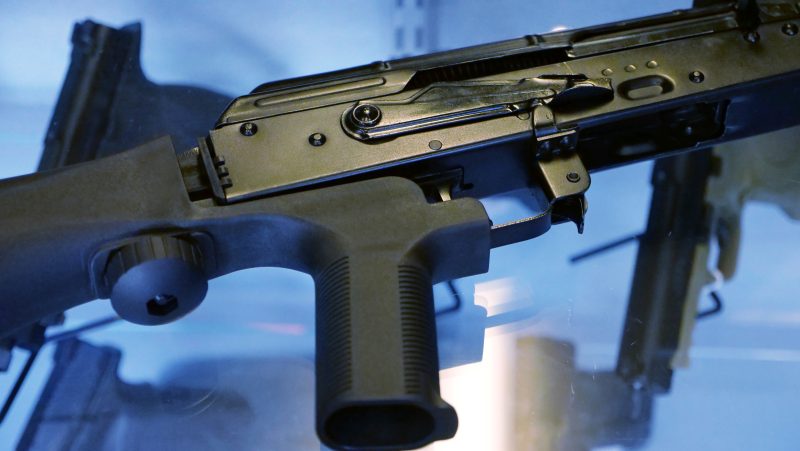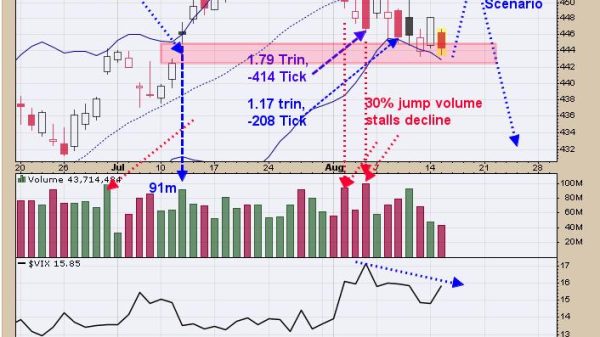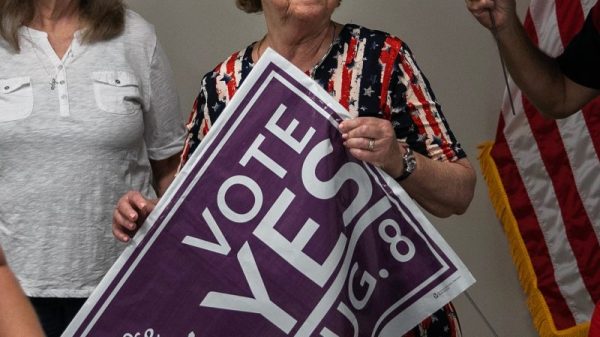After 58 people were killed and hundreds more injured at an outdoor music festival in Las Vegas, the Trump administration moved to ban bump stocks of the type used by the gunman to fire on the crowd in the deadliest mass shooting in modern U.S. history.
On Wednesday, the Supreme Court will consider whether that ban is legal — a decision that could invalidate federal restrictions on devices that modify semiautomatic rifles to fire hundreds of bullets per minute.
The bump stock ban represents one of the few steps by the federal government to address the mass killings that have become more frequent in the past decade, as both Congress and some courts have resisted efforts to place restrictions on firearms. The federal government began reexamining regulations on bump stocks after the 2017 shooting in Las Vegas, and the effort was reignited in early 2018 after the mass killing at Marjory Stoneman Douglas High School in Parkland, Fla.
Michael Cargill, a U.S. Army veteran and the owner of a gun store in Austin, challenged the Trump-era rules after he was forced to surrender two bump stocks. Cargill says the Bureau of Alcohol, Tobacco, Firearms and Explosives overstepped its authority when it reinterpreted long-standing federal limits on machine guns to cover the devices.
The case is one of two before the Supreme Court this term involving gun restrictions and one of several challenging the power of federal agencies, long targeted by conservatives wary of what they consider government overregulation.
Cargill is represented by the New Civil Liberties Alliance, one of the conservative legal organizations that is also behind an effort to upend a 40-year-old court precedent known as Chevron, which often requires judges to defer to the expertise of agency officials when evaluating statutes.
Cargill’s lawsuit to recover his bump stock devices was filed before the Supreme Court’s conservative majority made a landmark decision expanding gun rights in 2022 by requiring the government to point to historical analogues when defending laws that limit Second Amendment rights. That ruling is at issue in the other gun case before the court this term, which questions the legality of a law barring gun ownership by individuals subject to domestic-violence protective orders.
The question before the court Wednesday, in contrast, does not directly involve the Second Amendment. Instead, the justices will examine whether ATF officials properly interpreted a statute that has barred nonmilitary access to machine guns since 1986. Much of the discussion is likely to center on how a bump stock operates and whether its use amounts to a “single function of the trigger.”
The National Firearms Act defines machine guns as firearms that shoot, are designed to shoot or can be readily restored to shoot “automatically more than one shot, without manual reloading, by a single function of the trigger” as well as any part designed and intended solely “for use in converting a weapon into a machinegun.”
Bump stocks are molded pieces of plastic or metal that replace the standard rifle stock that rests against a shooter’s shoulder. The device harnesses a gun’s natural recoil, allowing the rifle to bounce or “bump” rapidly back and forth off a shooter’s trigger finger. Rifles equipped with bump stocks can fire an estimated 400 to 800 bullets per minute, a rate comparable to military machine guns, according to court filings.
The Biden administration, defending the Trump administration’s interpretation, told the court that the devices can be classified as machine guns because they are “designed and intended to permit users to convert a semiautomatic rifle so that the rifle can be fired continuously with a single pull of the trigger, discharging hundreds of bullets per minute.”
Quoting ATF, Solicitor General Elizabeth B. Prelogar said the agency’s 2018 rule clarified that “the term ‘automatically,’” as used in the definition of a machine gun, “means functioning as the result of a self-acting or self-regulating mechanism that allows the firing of multiple rounds through a single function of the trigger.”
Cargill’s attorneys, led by former Texas solicitor general Jonathan Mitchell, dispute the government’s description. The rapid fire is produced, they say, through repeated manual activations of the trigger — not a single motion.
The shooter must continually thrust the barrel or front grip of the rifle forward with his non-trigger hand, Mitchell wrote, while applying rearward pressure on the weapon with his trigger hand.
“These are manual functions, and there is no component in Cargill’s bump stocks that ‘automates’ the repeated firing of shots,” Mitchell told the justices in court filings. “There is no motor, no spring, no electrical device, or anything else that might automate a manual task.”
The agency’s assessment of bump stock devices and interpretation of the law has changed over time. In 2003, ATF said an early version was not a machine gun because it did not fire more than one shot with a single function of the trigger. Three years later, the agency changed its position and classified the early model with an internal spring as a machine gun.
Cargill’s attorneys emphasize that for nearly a decade, between 2008 and 2017, the federal government did not count later versions of the devices — without the internal spring — as machine guns. During that time, Americans bought 520,000 bump stocks.
Trump’s bump stock ban gave owners until March 2019 to destroy or turn over their devices. Other lawsuits seeking to block the ban were previously appealed to the Supreme Court after three appeals courts rejected challenges to ATF’s final rule. The justices did not agree to take any of those cases.
This time, a District Court and a unanimous panel of the conservative U.S. Court of Appeals for the 5th Circuit also sided with ATF and upheld the ban. The three-judge panel determined that a rifle modified with a bump stock fires multiple shots as the result of a self-regulating mechanism because the weapon “continue[s] firing until the shooter stops pushing forward with his non-shooting hand or the weapon runs out of ammunition.”
But the 5th Circuit reversed that ruling after a full complement of judges reheard the case. An eight-judge majority concluded the definition of machine gun in the statute does not cover bump stocks in part because “to continue firing after the shooter pulls the trigger, he or she must maintain manual, forward pressure on the barrel and manual, backward pressure [with the trigger finger],” Judge Jennifer Elrod wrote.
Five other judges argued that the definition was ambiguous but said the court was required under a rule of interpretation in cases involving criminal law to resolve the matter in Cargill’s favor.
In dissent, Judge Stephen Higginson, joined by two colleagues, criticized the majority for invoking the rule to “rewrite a vital public safety statute” and to “legalize an instrument of mass murder.”
The Justice Department then asked the Supreme Court to intervene.
The case is Garland v. Cargill.








